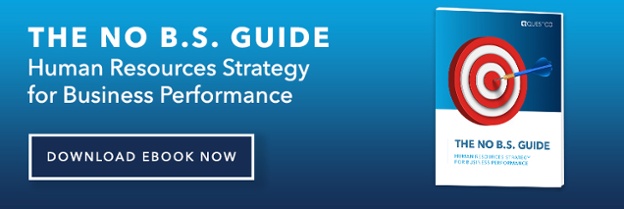Topic Outsourcing HR / PEO,
How to Optimize Human Resources So You Can Focus On Business Performance

December 27, 2019 | By Derek Carlstrom

According to Investopedia, the total cost of an employee is 1.5 – 3 times his or her salary due to the many costs associated with recruiting, hiring, training, and maintaining employees.
When these costs are not addressed and relieved, they can significantly cut a growing company's bottom line. In small businesses that do not yet have a dedicated HR administrator, this problem is typically even worse.
When you optimize human resources, you increase the productivity of whoever handles these tasks, lowering costs.
Here are eight steps to take to accomplish HR optimization:
1. Prioritize HR Tasks by Value and Urgency
Determine the value and urgency of each task by asking the following questions:
- Can someone else do this task better or less expensively?
- When does this task have to be completed by?
- Do resources need to be shifted to accomplish this task?
- What is the consequence of this task not being accomplished on time?
The answers to these four questions provide some insight into value and urgency. However, in some cases, not all answers will be aligned. For instance, a task may be able to be done for a more affordable price, but no resources exist to have the task done by the due date.
When this is the case, urgency must be weighed against value. It may be better to do a task more expensively to have it done by the due date. However, if there is no consequence of missing the due date, shifting the task’s timeline is the best option.
2. Supplement Existing Administrative Employees
The administrative burden that comes with HR strains the resources of even the biggest companies. To keep your employees focused on revenue-generating and otherwise essential tasks, outsource jobs that do not require in-house management. This leads to a more efficient use of human capital.
Businesses outside of California can hire freelance HR administrators (recent California laws limit a business’s ability to hire freelancers who do the jobs that the company already pays employees for).
However, as more freelancers are added to a company’s roster, more paperwork will pile up that freelancers were meant to relieve. Payroll becomes even more difficult when a company has full-time and freelance employees.
3. Plan for a Scalable HR Team
HR tasks seem simple enough when a company only has a handful of individuals.
But what about when the company has a full HR department handling dozens of employees who will need worker’s compensation, 401(K) plans, and regulatory compliance with the Fair Labor Standards Act (FLSA)?
Hiring more hands does not necessarily solve the problem. Understanding the federal, state, and local regulatory landscapes takes specialization. While hiring HR staff can help deal with administrative burdens, a full-time HR regulatory expert will cost a lot of money while only being needed occasionally.
Adding more full-time employees or freelancers leads to more work which will then require more hires. The solution is to find an HR partner who can handle administrative duties without adding administrative burdens to the HR department.
4. Ensure that Any Potential Outsourced HR Partner Does Not Create Liabilities
Find out how your potential partner handles cybersecurity and overall data safety. Also, consider how hard it will be to part ways if the relationship doesn't work out.
You should also be sure that adding an outsourced HR partner won't disrupt your company culture all that much, or preferably, at all.
A flexible partner improves employee engagement and avoids many hiccups compared to one that tries to make you adjust to its proprietary system.
5. Check the Certification of Potential Outsourced HR Partners
A certified HR outsourcing partner that uses co-employment is a “certified professional employer organization,” or CPEO. To gain CPEO status, the HR partner must undergo a strict application process and review with the IRS.
Each year, the PEO must get recertified.
Unlike other HR outsourcing solutions, the average return on investment for a PEO is 27.2%. At the same time, your in-house HR's administrative burden drops and gives them the extra bandwidth to focus on revenue-generating activities the grow your company.
While only a few PEOs are certified, the advantages of certification are enormous. If a company decides to start or stop doing business with a PEO, there is no taxable wage base restart or extra employment taxes. This is even though the loss of the HR partner changes the company’s Federal EIN number.
CPEOs can apply for R&D payroll tax credits for their partners. They also become the only liable party when it comes to payroll taxes.
6. Minimize Regulatory and Compliance Costs
Keeping up with regulations takes time and money, and one paperwork error can result in a costly corrective process.
Over the past 20 years, private wage and hour disputes have increased by 450%. In Texas, violations of the Fair Labor Standards Act (FLSA) since 1985 total over $250,000,000. This trend exists across industries, from retail and construction to healthcare and social assistance.
The FLSA is just one level of federal regulation faced by employers.
The Occupational Safety and Health Administration (OSHA) has its own regulations. Even if the employee is undocumented, the Department of Justice will investigate to ensure no violations occur.
Once federal regulations are handled, HR has to deal with regulations on the state level.
So, if you don't have a dedicated HR regulatory expert, ensure your HR partner has them on staff to reduce the risk of fines.
7. Lower Your Health Insurance Costs While Maintaining Benefits
Employees are demanding more and better health benefits from fitness reimbursements to health coaching. At the same time, the average premium paid for a family plan is $20,576 a year with the employer contributing, on average, $14,561.
Only 47% of firms with fewer than ten workers provide health coverage. This is partly because small firms cannot negotiate affordable prices with insurance companies. Large corporations with 1,000 or more employees can negotiate better deals thanks to their increased purchasing power.
When a company partners with a PEO, the company gains access to plans negotiated by that HR partner. That means small companies can get group health insurance for the same low price as major corporations.
8. Keep Your Client Services Agreement Flexible
Flexibility is essential when working with an outsourced HR partner. The best partners have "a la carte" packages and full-service offerings.
You can have them handle payroll, HR services, medical plan administration, worker's compensation, and more.
Alternatively, you can choose just payroll and HR services and have the HR partner work with your existing providers for the rest.
It is essential to make sure that ending the arrangement will not cause you undue hassle. All data should be transferred to you, and there should be no exit fees as long as you give reasonable advance notice. Many agree that 60 days’ notice is enough.
An outsourced HR partner can bring you many cost-optimization benefits. However, it's essential that you do the due diligence so you choose the right one. A mistake in selection can lead to data security risks and more administrative costs than if no partner were involved.
9. Streamline Workflows with an Integrated Human Resource Information System (HRIS)
As you seek new HR cost optimization initiatives to implement, another critical solution is to use a PEO's provided HRIS. An experienced and resourceful PEO will have reliable software solutions to help you get the best results from your HR management efforts.
You won't need to spend as much time and money on seeking the right software and procuring it when PEO services take care of this for you. A dependable PEO will also help ensure the HR technology you use is easy to adopt and integrate, maximizing your organization's efficiency.
One of the main advantages of using the right human resources information technology through PEO services is the ability to eliminate duplicative work by integrating modules such as time and attendance with payroll and others. The ideal systems will also provide plenty of insight, with real-time data analytics and insights that help improve efficiency. They'll also be able to use artificial intelligence and machine learning to further improve HR management capabilities.
Conclusion
There are many ways to optimize workforce management through effective HR optimization. By improving your company's HR and working with the right PEO, you'll see improved employee productivity, compliance, and other benefits. Taking the right steps to streamline HR workflows, relieve administrative burdens, and more can subsequently enable your business to experience real growth.
Take the time to find a dependable HR partner to help you implement the best solutions for your business. You'll ensure your organization flourishes long-term by appealing to top talent and keeping your workforce consistently compliant, productive, and satisfied.
FAQ about HR Optimization
What is a professional employer organization (PEO)?
While most HR outsourcing strategies only help save your company time, a professional employer organization (PEO) is an outsourcing solution that helps you save time and money to maximize ROI. You achieve this through a "co-employment" agreement that ensures you retain control over workforce planning while the PEO handles taxes, benefits, and more as an "employer of record." This relationship makes the PEO liable for HR compliance, reducing risk for your organization.
How can HR optimization contribute to a company's bottom line?
There are several ways you can increase your company's bottom line through HR optimization, but the best method is to use HR outsourcing. With the help of the right outsourcing partner, you can reduce costs and focus more on growing your business and performance management. Other advantages include legal compliance, reduced turnover costs, increased employee performance, a better employee experience, access to the best workforce optimization solutions, and more competitiveness in today's labor market.
Why is partnering with a PEO the best way to optimize human resources?
If you're looking for the most comprehensive solution to optimize HR, a PEO is the best option. By partnering with the right PEO, you'll experience numerous advantages over other forms of HR outsourcing. For example, you can get tax and payroll support, increased productivity among your teams, and access to robust workforce optimization software. You'll also maintain compliance regularly, free up more time for your in-house teams, improve risk management capabilities, and see higher ROI.
.jpg)
Derek Carlstrom
Derek is the Vice President of Sales Growth. He is a proactive leader with refined business acumen and exemplary people skills. He has progressive experience in sales leadership with the skills to drive business growth, capitalize on new revenue potential, and execute proper territory maximization




